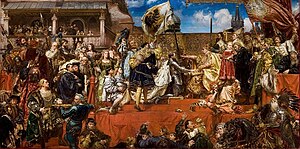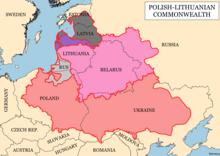Duchy of Prussia
Duchy of Prussia | |||||||||
|---|---|---|---|---|---|---|---|---|---|
| 1525–1618 | |||||||||
 Duchy of Prussia (striped) in the second half of the 16th century | |||||||||
| Capital | Königsberg | ||||||||
| Common languages | German, Polish, Prussian | ||||||||
| Religion | Protestant (Lutheran) | ||||||||
| Government | Monarchy | ||||||||
| Duke of Prussia | |||||||||
• 1525 — 1568 | Albert | ||||||||
• 1568 — 1618 | Albert Frederick | ||||||||
| History | |||||||||
| April 10 1525 | |||||||||
| August 27 1618 | |||||||||
| September 19 1657 | |||||||||
| |||||||||
The Duchy of Prussia or Ducal Prussia (German: Herzogtum Preußen; Latin: Ducatus Prussiae; Polish: Prusy Książęce; Lithuanian: Prūsijos kunigaikštystė) was a duchy in the eastern part of Prussia from 1525–1701. It was the first Protestant (Lutheran) duchy (It did not become a legal, sovereign, recognized state until the ruler received the title, 'King in Prussia', in 1701), with a dominant German-speaking population, as well as Polish and Lithuanian minorities. In old texts and in Latin the term Prut(h)enia refers to Ducal Prussia, its western neighbour Royal Prussia and their common predecessor Teutonic Prussia alike. The pertaining comtemporary adjective is Prut(h)enic.
In 1525 during the Protestant Reformation, the Grand Master of the Teutonic Knights, Albert, secularized the order's Prussian territory, becoming Albert, Duke of Prussia. His duchy, which had its capital in Königsberg (Polish: Królewiec), was established as fief of the Crown of Poland. It was inherited by the Hohenzollern prince-electors of Brandenburg in 1618; this personal union is referred to as Brandenburg-Prussia. Frederick William, the "Great Elector" of Brandenburg, achieved full sovereignty over the territory in the 1657 Treaty of Wehlau, which was confirmed in the 1660 Treaty of Oliva. The Duchy of Prussia was elevated to the Kingdom of Prussia in 1701.
History
Background
As Protestantism spread among the laity of the Teutonic Monastic State of Prussia, dissent began to develop against the Roman Catholic rule of the Teutonic Knights, whose Grand Master, Albert of Brandenburg-Ansbach, a member of a cadet branch of the House of Hohenzollern, lacked the military resources to assert the order's authority. After losing a war against the Kingdom of Poland, and with his personal bishop, Georg von Polenz of Samland, and a number of his commanders already supporting Protestant ideas, Albert began to consider a radical solution. At Wittenberg in 1522 and at Nuremberg in 1524, Martin Luther encouraged him to convert the order's territory into a secular principality under his personal rule, as the anachronistic Teutonic Knights would not be able to survive the Protestant Reformation.[1]
Establishment
On April 10 1525 Albert resigned his position, became a Protestant, and in the Prussian Homage was granted the title "Duke of Prussia" by his new feudal overlord, King Sigismund I the Old of Poland, who was also his uncle. In a deal partially brokered by Luther, Ducal Prussia became the first Protestant state, anticipating the dispensations of the Peace of Augsburg of 1555. The "S" on the duchy's coat of arms represented Albert's sovereign, Sigismund. Charles V, Holy Roman Emperor, and Pope Clement VII objected to the Prussian Homage, which was derided as the Krakauer Kuhhandel ("Cracow cow-trading").
When Albert returned to Königsberg (Polish: Królewiec), he publicly declared his conversion and announced to a quorum of Teutonic Knights his new ducal status. The knights who disapproved of the decision were pressured into acceptance by Albert's supporters and the burghers of Königsberg, and only Eric of Brunswick-Wolfenbüttel, Komtur of Memel, opposed the new duke. By the end of Albert's rule, the offices of Großkomtur and Ordensmarschall had deliberately been left vacant and the order had only 55 knights in Prussia. Some of the knights converted to Lutheranism in order to retain their property and then married into the Prussian nobility, while others returned to the Holy Roman Empire and remained Catholic.[2] These remaining Teutonic Knights, led by the next Grand Master, Walter von Cronberg, continued to unsuccessfully claim Prussia.

On 1 March 1526 Albert married Princess Dorothea, daughter of King Frederick I of Denmark, thereby establishing political ties between Lutheranism and Scandinavia. Despite his Protestant creed, Albert was greatly aided by his older brother George, Margrave of Brandenburg-Ansbach, who had already earlier established Protestant religion in his territories of Franconia and Upper Silesia. Albert also found himself reliant on support from his Jagiellonian uncle Sigismund I of Catholic Poland, as the Holy Roman Empire and the Roman Catholic Church had banned him for his Protestantism.
Because Ducal Prussia was ostensibly a Lutheran land, authorities travelled throughout the duchy ensuring that Lutheran teachings were being followed and imposing penalties on pagans and dissidents. There was little active resistance to the new creed, although the fact that the Teutonic Knights had brought Roman Catholicism and Protestantism made the transition easier.[3] While there was little longing for Catholicism, Baltic Prussian peasants continued to practice pagan customs in some areas, for example adhering to beliefs in Perkunos, Potrimpos, and Pikullos (Patollu) while "consuming the roasted flesh of a goat".[4]

| History of Brandenburg and Prussia |
|---|
  |
|
| Present |
|
A peasant rebellion broke out in Sambia (German: Samland) in 1525. The combination of taxation by the nobility, the furor of the Protestant Reformation, and the abrupt secularization of the Teutonic Order's remaining Prussian lands exacerbated peasant unrest. The relatively well-to-do rebel leaders, including a miller from Kaimen and an innkeeper from Schaaken, were supported by sympathizers in Königsberg. The rebels demanded the elimination of newer taxes by the nobility and a return to an older tax of two marks for every Hufe (approximately forty acres). They claimed to be rebelling against the harsh nobility, not against Duke Albert, who was away in the Holy Roman Empire, but they would only swear allegiance to him in person. Upon Albert's return from the Empire, he called for a meeting of the peasants in a field, whereupon he surrounded them with loyal troops and had them arrested without incident; the leaders of the rebellion were subsequently executed.[4] Although there were no more large-scale rebellions, Ducal Prussia became known as a land of Protestant dissent and sectarianism.[3] While the composition of the nobility changed little in the transition from monastic state to duchy, the hold of the nobility over the peasantry increased. The peasant rebellion had frightened the nobles, however, causing them to look to Duke Albert for leadership.
Administratively, little changed in the transition from the Teutonic Knights to ducal rule. Although he was formally a vassal of the crown of Poland, Albert retained self-government for Prussia, his own army, the minting of his currency, a provincial assembly (Prussian Diet, Landtag), and had substantial autonomy in foreign affairs.[5]
Lack of heirs
When Albert died in 1568, his teenage son Albert Frederick inherited the duchy; Joachim II, Elector of Brandenburg, secured co-enfeoffment (Mitbelehnung) of the duchy in the same year. Administration in the duchy declined as Albert Frederick became increasingly feeble-minded, leading Margrave George Frederick of Brandenburg-Ansbach to become Regent of Prussia in 1577.
Transition into Brandenburg-Prussia in 1618
As Albert Frederick had no surviving male heirs, the Treatise of Warsaw in 1611 allowed his son-in-law, Elector John Sigismund of the Hohenzollern branch in Brandenburg, to become the duke's legal successor. In 1618, the Thirty Years' War broke out, and Albert Frederick died, with the duchy passing to John Sigismund, who himself died the following year. John Sigismund's son, George William, was successfully invested with the duchy in 1623 by the king of Poland, Sigismund III Vasa, thus the personal union Brandenburg-Prussia was confirmed.[3] Many of the Prussian Junkers were opposed to rule by the House of Hohenzollern of Berlin and appealed to Sigismund III Vasa for redress, or even incorporation of Ducal Prussia into the Polish kingdom, although without success.[6] Brandenburg, being a fief of the Holy Roman Empire, and Ducal Prussia, being a Polish fief, made a cross-border real union legally impossible. De facto Brandenburg and Ducal Prussia were more and more ruled as one, and colloquially referred to as Brandenburg-Prussia.
Frederick William the Great Elector, duke of Prussia and prince-elector of Brandenburg, was after acquiring Royal Prussia in order to territorially connect his two fiefs. So he took the opportunity when Charles X Gustav of Sweden, in his attempt to conquer Poland (cf. Swedish Deluge), promised to cede to Frederick William the Prince-Bishopric of Ermland and four further Polish voivodeships, if Frederick William would support Charles Gustav's effort.[7] The deal was a mere spec, since Frederick William would definitely have to provide military support, while the reward was only under the condition of a victory.
King John II Casimir of Poland didn't take the Swedish-Prussian alliance lying down. He submitted a counter-offer and Frederick William accepted. On July 29, 1657 they signed the Treaty of Wehlau in Wehlau (Polish: Welawa; now Znamensk). In return for Frederick William's renunciation of the Swedish-Prussian alliance, John Casimir recognised Frederick William's full sovereignty over the Duchy of Prussia.[7] After almost 200 years of Polish suzerainty over the Teutonic Monastic State of Prussia and its successor Ducal Prussia, full sovereignty was regained. Therefore Duchy of Prussia then became the more adequate appellation for the state. Full sovereignty was a necessary prerequisite for upgrading Ducal Prussia to become the sovereign Kingdom of Prussia, not to be confused with Polish Royal Prussia, in 1701.
Kingdom in 1701
Ducal Prussia's full sovereignty allowed Elector Frederick III of Brandenburg to become "king in Prussia" in 1701 without offending Emperor Leopold I. The government of de facto collectively ruled Brandenburg-Prussia, seated in Brandenburg's capital Berlin, mostly appeared under the higher ranking titles of Prussian government. After the Kingdom of Prussia's annexation of Royal Prussia in 1772, a year later former Ducal Prussia including formerly Royal Prussian Warmia (German: Ermland) was reorganised into the Province of East Prussia, while most of former Royal Prussia became the Province of West Prussia. The Kingdom of Prussia, then consisting of East and West Prussia, being a sovereign state, and Brandenburg, being a fief within the Holy Roman Empire, were only amalgamated legally after the latter's dissolution in 1806.
See also
References
- ^ Christiansen, Eric. The Northern Crusades. Penguin Books. London, 1997. ISBN 0-14-026653-4
- ^ Seward, Desmond. The Monks of War: The Military Religious Orders. Penguin Books. London, 1995. ISBN 0-14-019501-7
- ^ a b c Koch, H.W. A History of Prussia. Barnes & Noble Books. New York, 1978. ISBN 0-88029-158-3
- ^ a b Kirby, David. Northern Europe in the Early Modern Period: The Baltic World, 1492–1772. Longman. London, 1990. ISBN 0-582-00410-1
- ^ Urban, William. The Teutonic Knights: A Military History. Greenhill Books. London, 2003. ISBN 1-85367-535-0
- ^ Eulenberg, Herbert. The Hohenzollerns. Translated by M.M. Bozman. The Century Co. New York, 1929.
- ^ a b Rutkowski, Henryk 'Rivalität der Magnaten und Bedrohung der Souveränität', in: Polen. Ein geschichtliches Panorama, Warszawa: Wydawnictwo Interpress, 1983, pp. 81-91, here p. 82. ISBN 83-223-1984-3 Cite error: The named reference "Rutkowski" was defined multiple times with different content (see the help page).



